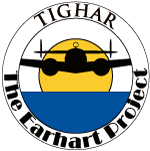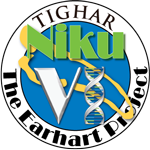|
2010: Niku VI
Expedition

Updates |
|
To avoid
lengthy download times, the updates are divided into seven
day periods. This is the first week of the expedition. Date links refer
to U.S. days; Nikumaroro is on the other side of the date line, so it’s
tomorrow there.
|
| Reports
are in reverse date order so that those who check every day don't have to
scroll down endlessly as the expedition progresses. |
|
If
you are new to this page, just click on the earliest date to the left (down
at the bottom of the list) and then scroll up to read each posting in order. |
| Dateline: Nikumaroro, 0530 Local Time, 30 May 2010. |
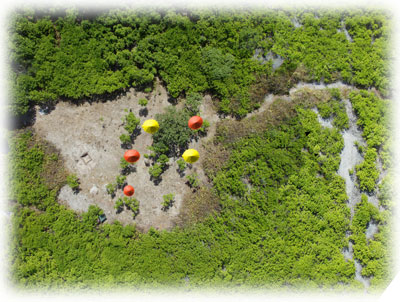 Excavation continued at the Seven Site. Bill Carter found yet another fire feature, and it seems possible that the features are in a rough ring around the big Ren tree, although more data points are needed. Did the castaway construct a ring of fire to keep away the crabs at night? We can’t know yet, but it’s an interesting speculation. Excavation continued at the Seven Site. Bill Carter found yet another fire feature, and it seems possible that the features are in a rough ring around the big Ren tree, although more data points are needed. Did the castaway construct a ring of fire to keep away the crabs at night? We can’t know yet, but it’s an interesting speculation.
Megan found a shark tooth which may have a hole drilled through it. This could have been dropped by a colonist, or it could be prehistoric. Another piece of Tiny Technology, like that found Thursday, was also found. Did some sort of instrument or machine get disassembled or broken here?
The Seven Site is now defined northward. Enough work has been done towards the Buka forest that a boundary can be set. Today, the lane cut by Bill and Karl will be surveyed and metal detected in hopes of finding a similar “edge” to the south.
The ROV, aboard Nai’a, had a tough time yesterday getting close enough to the reef to provide a stable platform for operations. When the wind kicks up there’s a lot of surface area to catch it. Then a two knot current developed and the ROV was unable to stem it. So Jesse and Walt went over to the lagoon and did another chunk of AUV side-scan sonar work there.
Mark and Andrew stayed overnight on the island at the Seven Site, so Mark could get some particular shots he wanted. When Ric called they hadn’t heard anything yet, but presumably the campers didn’t get eaten by the crabs.
Morale is good. Digging, while not terribly exciting most of the time, is at least less brutal physically than hacking scaevola.
|
| Dateline: Nikumaroro, 0500 Local Time, 29 May 2010. |
The Dynamic Duo, a.k.a. Bill Carter and Karl Kern, have completed their trail in from the ocean side to the main Seven Site. It was very rough work, and they will now stand down for a day or two to recuperate. The cleared trail will be gone over with metal detectors and subjected to a visual survey to see if there is any scattering of artifacts or interesting things that would justify further expansion of the clearing.
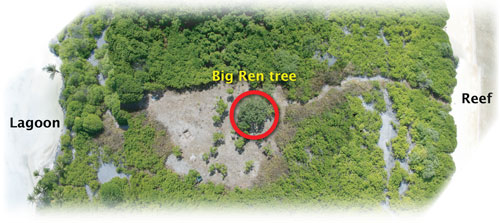 At the Seven Site, Megan found a new fire feature under the big ren tree. This is very exciting as it adds another layer of evidence to our hypothesis that the castaway spent quite a bit of time in the area. The excavation continues to turn up bird and fish bones, as well. At the Seven Site, Megan found a new fire feature under the big ren tree. This is very exciting as it adds another layer of evidence to our hypothesis that the castaway spent quite a bit of time in the area. The excavation continues to turn up bird and fish bones, as well.
Andrew found a very small man-made artifact. It is a plastic (?) threaded knob-like object, very small, which seems to possibly be some sort of cover for an opening in something. It appears to have a “1” or a lower case “L” stamped on the inside. The cameraman says he hasn't dropped anything.
The ROV team used the short cable to cover the reef slope north of Norwich City down to 150 meters. Today they will continue to the south of the wreck. The slope is very steep, and there were no ledges, and no man-made objects (although they did see a hammerhead shark). When the long cable arrives with the second boat, they will cover the same areas again, down to 300 meters (almost 1,000 feet). They are working very intensively as long as the wind and weather hold, because it can easily get too rough to be able to hold station safely.
Clearing at the Seven Site is done for now, and the digging continues apace.
|
| Dateline: Nikumaroro, 0545 Local Time, 28 May 2010. |
 Ric, Gary, and Mark went to look at the “Nessie” location, which involves a slogging hike around the end of the island, and then out onto the reef. Using GPS and the spot marked by our forensic imaging specialist, they arrived at the correct area at dead low tide. Ric, Gary, and Mark went to look at the “Nessie” location, which involves a slogging hike around the end of the island, and then out onto the reef. Using GPS and the spot marked by our forensic imaging specialist, they arrived at the correct area at dead low tide.
That part of the reef is shaped somewhat like a crowned road, a higher area with a lower swale inshore, and a gradual slope towards the surf line as well. The higher area is perfectly landable, but is bordered by jagged, pitted coral rock inland, and the slope and spurs and grooves seaward. Insofar as they were able to pinpoint their location accurately (and there is some slop in the coordinates), there appears to be a groove just a few meters from the spot where Nessie was photographed. Ric tells me that if you stand there and look back towards the Norwich City, it’s just about the right place to have approached over the wreck of the ship, land, and roll out. Each roller coming in carries sharks surfing along, which would be somewhat disquieting to anyone trying to walk around out there, getting in and out of an airplane.
At the Seven Site the excavation continued, a little faster now as people’s eyes get tuned to the terrain and the debris. They continue to find bird and fish bones, but so far nothing else. The team is using trowels to pull surface into gray dustpans, then with the tip of the trowel pushing it back out, and watching for anything interesting as each piece exits. Very painstaking work, but we can’t sacrifice thoroughness for speed: teeth are small.
Meanwhile, a team of four (Bill Carter, Karl Kern, and two crew members, Moses and Kuroi) have cut in from the ocean side about 60 meters, making a path about 2 meters wide, and will turn north today to connect with the main area in about 30 meter. This will give a sampling of the area outside the search site for comparison, and of course if anything is found will justify expanding the search area.
The ROV worked a few hundred meters north of the Norwich City yesterday, but the wind kicked up until Nai’a could no longer hold station safely that close to the reef, so they had to knock off at about a 100 meter depth. The weather is forecast to be much calmer today and tomorrow, so they should be able to get a lot done. Walt and Jesse went around and tried snorkeling on some of the sonar targets in the lagoon, but the wind had so disturbed the sediment and water that visibility was almost zero. They’ll have to wait for a day without whitecaps on the lagoon to get much done there.
Today: More of the same. Rinse and repeat.
|
| Dateline: Nikumaroro, 0530 Local Time, 27 May 2010. |
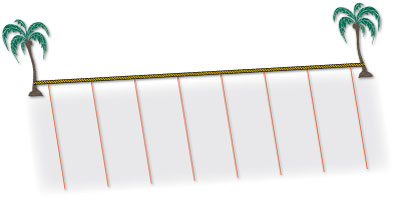 Yesterday was the first day of digging at the Seven Site. Tom’s plan involves stretching a line between two defined points, with the line divided into seven segments or lanes, each bordered by a brightly colored string. Beginning at the north end, the workers will trowel down to the 10 cm level, closely inspecting everything they move for anything anomalous. Yesterday the concept was proved by finds of additional turtle and bird bone. Yesterday was the first day of digging at the Seven Site. Tom’s plan involves stretching a line between two defined points, with the line divided into seven segments or lanes, each bordered by a brightly colored string. Beginning at the north end, the workers will trowel down to the 10 cm level, closely inspecting everything they move for anything anomalous. Yesterday the concept was proved by finds of additional turtle and bird bone.
Meanwhile, Ric was metal detecting the area. It’s been done before, and will be done again, and we always find new things. In this case, besides another nail (a common find), he found the remains of a pencil: the little metal band which goes around the eraser, and the stick of graphite from the middle. The wood was completely gone except for a very small amount inside the eraser clamp.
The ROV began working about 600 meters north of the wreck of the Norwich City, and confirmed the underwater topography: aside from the two ledges at 50 and 100 m, they went to 900 feet without being able to see any bottom. If the aircraft wreckage did not land on one of those two ledges, it may well be gone for good.
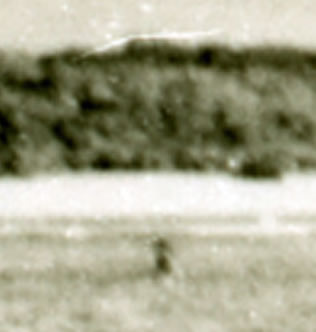 The pig bones from 2007 were collected for use as comparison with coral rubble. It’s very important that the group has mammal bones from three years ago for this purpose, as that is the time frame Gerald Gallagher would have been looking at if he did, indeed, find the bones of Amelia Earhart. The pig bones look very old and weathered, and also distressingly like coral rubble. But they are much lighter in weight than the coral, which is helpful. The pig bones from 2007 were collected for use as comparison with coral rubble. It’s very important that the group has mammal bones from three years ago for this purpose, as that is the time frame Gerald Gallagher would have been looking at if he did, indeed, find the bones of Amelia Earhart. The pig bones look very old and weathered, and also distressingly like coral rubble. But they are much lighter in weight than the coral, which is helpful.
During lunch a large centipede came to investigate the smells? … who knows what a centipede senses. But large he was, and when Tom Roberts touched him with his boot, the critter ran up his leg. Luckily outside his pants, because they leave a terrible chemical weal if they touch your skin. Lonnie was able to flip it off with an implement, and Karl ushered Mr. Centipede out of the area. Team work is very important on our expeditions. So is learning a basic rule first-hand: Don’t pet the bunnies and squirrels. Some of them bite.
Today the work at the Seven Site will continue. During the first half of the day, Gary, Mark and Ric will be landed on the north side of Taziman Passage, and they will walk around the north side of the island to investigate the site of “Nessie” out on the reef. Today promises good weather and a very low tide, so it’s a good day to make this excursion. We don’t really think there's anything still there, but we have to look.
|
| Dateline: Nikumaroro, 0630 Local Time, 26 May 2010. |
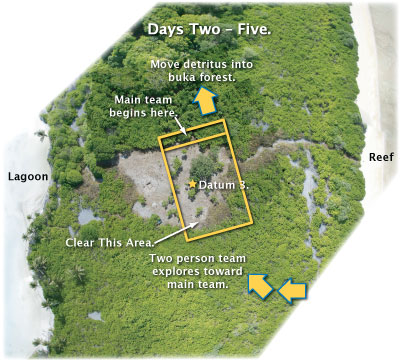 Serious clearing work began at the Seven Site yesterday – and was finished. The gang was able to do in two days what took a week in 2007, in part because the scaevola is young and easier to cut, but also because everyone worked like six horses. The clearing is done and today the actual digging will commence, according to Tom’s plan. Everything is being filmed and photographed continuously. Mark even has a still camera mounted to shoot infrared in order to see what goes on there at night. Serious clearing work began at the Seven Site yesterday – and was finished. The gang was able to do in two days what took a week in 2007, in part because the scaevola is young and easier to cut, but also because everyone worked like six horses. The clearing is done and today the actual digging will commence, according to Tom’s plan. Everything is being filmed and photographed continuously. Mark even has a still camera mounted to shoot infrared in order to see what goes on there at night.
The ROV worked around the Norwich City, looking at the debris field there and also at the slope and ledges to get a feel for the topography. There is a ledge at about 50 meters, and another at about 100 meters. After that, it drops off very smoothly at around 80° as
far as the cameras could see. Possibly the longer cable, which will arrive with the second boat, will allow them to find a bottom; but it seems likely that anything that does not hang up on one of those two ledges is very deep indeed.
Ric and one other person will begin laying out a perimeter search in the buka forest with the objective of finding any bones that may have been taken by crabs. Bill and Leonid will run an exploratory line from the ocean shore in towards the main site in order to pick up any wandering artifacts that may have been separated from the known site by water or critters.
Meanwhile, the main walk-in cooler on Nai’a has developed a problem, causing a good bit of food to spoil. It is indeed a Good Thing that VvS1, the second boat, will be arriving at the halfway point, because otherwise they’d be down to fish and coconuts for the trip home. As it is, stores, the new ROV cable, and some odds and ends of equipment will arrive with the fresh troops.
Everyone is feeling great and is in good spirits. |
| Dateline: Nikumaroro, 0630 Local Time, 25 May 2010. |
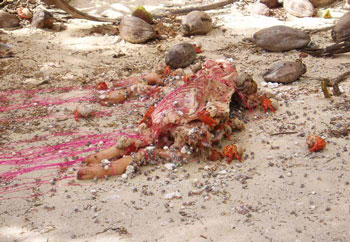 During the day yesterday a group visited the pig taphonomy experiment site from Niku V in 2007. It was a very interesting experience. By the end of the trip last time, all edible material had been stripped from the bones of the pig, and the crabs seemed to have lost interest in the dry bones. The visit yesterday confirmed that thought: the bones were still there, right where they’ve been for three years. They had been washed somewhat inland by a storm, but otherwise were undisturbed. During the day yesterday a group visited the pig taphonomy experiment site from Niku V in 2007. It was a very interesting experience. By the end of the trip last time, all edible material had been stripped from the bones of the pig, and the crabs seemed to have lost interest in the dry bones. The visit yesterday confirmed that thought: the bones were still there, right where they’ve been for three years. They had been washed somewhat inland by a storm, but otherwise were undisturbed.
The other thing about them that was very interesting is that they looked old. Much older than three years. As old, in fact, as Gallagher reported “his” bones looking: gray, pitted, dry. The bones will be collected used for comparison and visual training.
The Seven Site crew opened trails straight through from lagoon to ocean yesterday, moved in all the gear, and assembled and tested those things which needed to be assembled and tested. Everything works. Lonnie, Megan, Gary, and Ric searched for fire features in the village without much success; apparently the ground has just been too much disturbed by repeated storms for fire remains to be readily apparent. One possibility was found and will be looked at more closely.
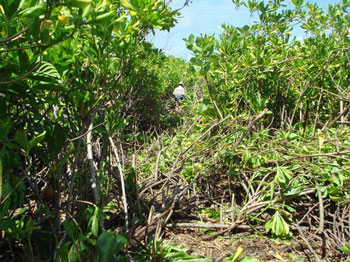 Jesse began the lagoon survey with the AUV and completed about 10% of the area in the first day. Last night, he put the ROV over the side of Nai’a for testing. They had two large flat screen monitors set up where everyone could watch as he “flew” the ROV under the boat, around the reef, coming nose to nose with various fish. Today they will begin familiarization with the wreckage of the Norwich City and start “tuning” their eyes to the environment. A cable was damaged in transit, so they are using a shorter cable until the new one can arrive on the second boat. Jesse began the lagoon survey with the AUV and completed about 10% of the area in the first day. Last night, he put the ROV over the side of Nai’a for testing. They had two large flat screen monitors set up where everyone could watch as he “flew” the ROV under the boat, around the reef, coming nose to nose with various fish. Today they will begin familiarization with the wreckage of the Norwich City and start “tuning” their eyes to the environment. A cable was damaged in transit, so they are using a shorter cable until the new one can arrive on the second boat.
Otherwise, it’s a scaevola-whacking day. The Seven Site must be cleared completely in order to begin to execute the plan for excavation. Not just cut down, but all debris carried (not dragged!) away, leaves picked up, surface litter removed, all in 120° heat. This is not fun.
|
| Dateline: Nikumaroro,
0530 Local Time, 24 May 2010. |
Nai’a arrived off Nikumaroro at around day break yesterday, and by 9 a.m. everyone was ashore on a low tide. Most of the gang began clearing the “Gallagher Highway” – the trail across the island to the lagoon shore – while Ric took three of the new people, Curtis, Leonid, and Karl, to look at the village for orientation. They walked around on the beach, looking for signs of storm damage and washup.
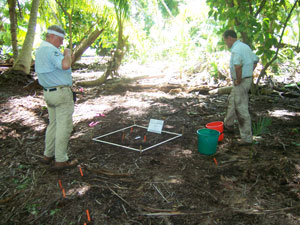 There was a lot more trash on the beach than in the past – flip flops, plastic bottles, fishing floats, all the debris of civilization washed up on one of the most remote islands on earth. There were two big storm berms along the north side of village, by Taziman Passage, which completely covered the concrete pad of the radio shack and also the excavations done in 2007. The Rest House site was still intact, and Gallagher’s grave as well, although they did remove a fallen tree from it. There was a lot more trash on the beach than in the past – flip flops, plastic bottles, fishing floats, all the debris of civilization washed up on one of the most remote islands on earth. There were two big storm berms along the north side of village, by Taziman Passage, which completely covered the concrete pad of the radio shack and also the excavations done in 2007. The Rest House site was still intact, and Gallagher’s grave as well, although they did remove a fallen tree from it.
After a break, during which they became objects of extreme interest to a gaggle of frigate birds, they continued around to Club Fred on the lagoon shore where they met the rest of the group emerging from the jungle. By then it was high tide, so it was time to bring a boat into the lagoon. The tide was high enough to load the boat with all the heavy equipment for the Seven Site, which was a great relief to all as it’s no fun to carry hundreds of pounds of gear across the island. A small team took the boat down the lagoon to the Seven Site, marking coral heads as they went. They reported back that the trail was still quite clear, although the site itself has grown up to ten foot tall scaevola.
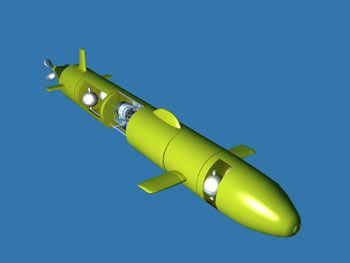 While this excursion was taking place, Jesse and Walt were testing the Autonomous Underwater Vehicle (AUV). It’s rather like a torpedo in appearance, and its function is to map the lagoon floor with high quality side scan sonar. You program it, put it in the water, and away it goes, coming back and parking itself at a site you designate. That’s the theory, anyway, and in fact that’s just what happened, which pleased Jesse. The equipment is borrowed, you see …. (the illustration at right is an example of what these things look like, not a picture of the one they are using). While this excursion was taking place, Jesse and Walt were testing the Autonomous Underwater Vehicle (AUV). It’s rather like a torpedo in appearance, and its function is to map the lagoon floor with high quality side scan sonar. You program it, put it in the water, and away it goes, coming back and parking itself at a site you designate. That’s the theory, anyway, and in fact that’s just what happened, which pleased Jesse. The equipment is borrowed, you see …. (the illustration at right is an example of what these things look like, not a picture of the one they are using).
The plan for today is simple: go to the Seven Site and begin clearing scaevola. The lagoon survey will also be started. A small team will be looking for a fire feature in the village to excavate as a control against the fire features at the Seven Site.
Morale is very high and everyone is ready to get to work.
|
|
|

